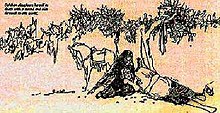| Mirza Sahiban | |
|---|---|
 Photograph of a fresco illustrating Mirza being killed by Sahiban’s brothers, artwork located at Palkiana Sahib near Tarn Taran, taken in 1971 Photograph of a fresco illustrating Mirza being killed by Sahiban’s brothers, artwork located at Palkiana Sahib near Tarn Taran, taken in 1971 | |
| Folk tale | |
| Name | Mirza Sahiban |
| Region | Punjab |
| Origin Date | 17th century |
| This article is part of the series |
| Punjabi folklore ਪੰਜਾਬੀ ਲੋਕਧਾਰਾ • پنجابی لوک ریت |
|---|
| Romances |
| Folk figures |
|
|

Mirza Sahiban (Punjabi: [mɪɾzaː saːɦɪbãː]) is a traditional Punjabi tragedy originally written by the 17th-century poet Pilu. Set in a village in Jhang, the tragedy follows the romance between two youths, belonging to chieftain families of their respective clans, their elopement and eventual demise.
It is regarded as one of the four popular tragic romances of the Punjab. The other three are Heer Ranjha, Sohni Mahiwal and Sassi Punnun.
Synopsis
The story was written by Pilu, a poet who lived during 16th century in Punjab. Mirza and Sahiban were lovers who lived in Khewa, a town in the Jhang District which was Sahiban's ancestral village. Mirza was the son of Banjal, a Kharal Jatt chief of Danabad while Sahiban was the daughter of Khiva Khan, a Sial Jatt chief.

Both Mirza and Sahiban ran away to marry against Sahiban's parents' wishes. While eloping Mirza stopped under a jand tree, where he rested for a while and fell asleep. Sahiban did not want to begin her new life through her brothers' bloodshed. She decided to break all the arrows of Mirza thinking she will beg her brothers for their acceptance so that nobody would get hurt. When Sahiban's brothers reached near them, Mirza woke up but discovered that his arrows were broken, and was killed by Sahiban's brothers. Sahiban could not bear this loss and chose to end her own life by stabbing herself with an arrow.
Adaptations
There have been various film interpretations of the folk tale:
- Mirza Sahiban, a 1929 Indian silent film by Bhagwati Prasad Mishra.
- Mirza Sahiban, a 1933 Indian Hindi-language film by Nagendra Majumdar starring Khurshid Begum and Kamlabai Gokhale.
- Mirza Sahiban, a 1939 Indian Punjabi-language film by D. N. Madhok starring Zubeida.
- Mirza Sahiban, a 1947 Indian Hindi-language romantic-drama film by K. Amarnath starring Noor Jehan and Trilok Kapoor
- Mirza Sahiban (1956) is a Pakistani Punjabi film starring Musarrat Nazir and Sudhir
- Mirza Sahiban (1957 film), a 1957 Indian Hindi-language romance film by Ravi Kapoor starring Shyama and Shammi Kapoor.
- Mirza Jat (1967) is a Pakistani Punjabi film starring Firdous and Ejaz Durrani
- Mirza Jat (1982) is a Pakistani Punjabi film starring Shahid Hameed.
- Mirza Jatt, a 1992 Indian Punjabi-language romance film by Ravinder Ravi starring Gugu Gill and Manjeet Kullar.
- Hero Hitler in Love, a 2011 Indian Punjabi-language film by Babbu Maan, starring Maan and Mouni Roy. It creates a modern Mirza and Sahiban story with a twist.
- Mirza – The Untold Story, a 2012 Indian Punjabi-language film directed by Baljit Singh Deo starring Gippy Grewal and Mandy Takhar. It is a modern rendition of Mirza and Sahiban story, with the title song sung by Arif Lohar, son of (late) Alam Lohar.
- Mirzya, a 2016 Indian Hindi-language film directed by Rakesh Omprakash Mehra, is based on Mirza and Sahiban and closely follows the original story. Harshvardhan Kapoor plays Mirza and Saiyami Kher plays Sahiba.
- Mirza Juuliet, a 2017 Indian Hindi-language film directed by Rajesh Ram Singh, starring Darshan Kumar and Piaa Bajpai in the lead roles. It is a modern retelling of the original story, set in Uttar Pradesh, showing the nexus between politicians and criminals.
- Phillauri, a 2017 Indian film starring Diljit Dosanjh and Anushka Sharma in lead roles, the song Sahibaa portrays their love in comparison with Mirza Sahiban .
- Diljit Dosanjh, a 2017 Indian Hindi-language film directed by Rajesh Ram Singh, starring Darshan Kumar and Piaa Bajpai in the lead roles. It is a modern retelling of the original story, set in Uttar Pradesh, showing the nexus between politicians and criminals.
- In 2022 Indian film Jersey featured song 'Maiyya mainu' by Sachet–Parampara compared Shahid Kapoor and Mrunal Thakur with mirza-sahiban.
Notes
- Punjabi: مرزا صاحباں, ਮਿਰਜ਼ਾ ਸਾਹਿਬਾਂ; mirzā sāhibāṁ
References
- Jamal Shahid (11 January 2015). "A beloved folk story comes to life". Dawn. Retrieved 8 November 2020.
- ^ Karan Bali (13 September 2016). "Before 'Mirzya', Mirza and Sahiban have died over and over again for their love (Numerous versions of the legend exist, including productions in Punjabi on both sides of the border)". Scroll.in website. Retrieved 8 November 2020.
- "Love Legends in History of Punjab". Punjabi World website. 20 April 2007. Archived from the original on 22 March 2019. Retrieved 8 November 2020.
- Sahibaan remains unheard. The Hindu (newspaper), Published 11 October 2016. Retrieved 8 November 2020.
- ^ Banga, Indu (2005). "Appendix - The Story of Mirza and Sahiban in Pilu's Narrative". In Grewal, Reeta; Pall, Sheena (eds.). Precolonial and Colonial Punjab: Society, Economy, Politics, and Culture: Essays for Indu Banga. Manohar. p. 171. ISBN 9788173046544.
Mirza was the son of Banjal, a Kharal Jat Chief of Danabad in the Montgomery district. Sahiban was the daughter of the Jat Chief Khiva Khan belonging to the Syal clan ...
- ^ Rajadhyaksha, Ashish; Willemen, Paul (1999). Encyclopaedia of Indian cinema. British Film Institute. ISBN 9780851706696. Retrieved 12 August 2012.
- Mirza Jat (1982 film) on Complete Index To World Film (CITWF) website Retrieved 8 November 2020
- Ruchi Kaushal (16 December 2015). "WATCH: Harshvardhan Kapoor's 'Mirziya' logo trailer unveiled!". The Times of India (newspaper). Retrieved 8 November 2020.
- Bibliography
- Swynnerton, Charles (1903). "The Love Story of Mîrza and Sâhibânh". Romantic Tales From Punjab. Westminster: Archibald Constable & Co. Ltd. pp. 365–407.